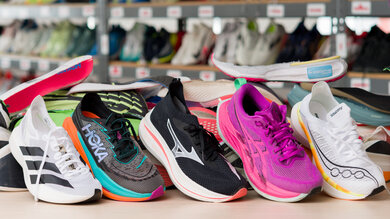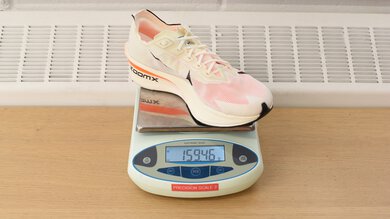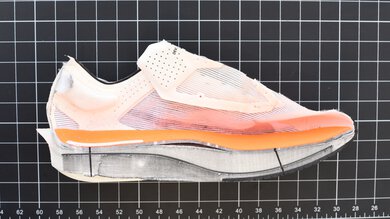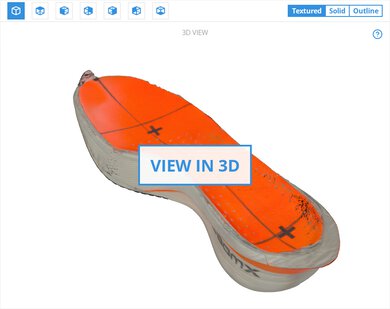The Nike Vaporfly 4 is a lightweight racing shoe designed for runners chasing fast times across shorter races from the 5K up to the half-marathon. It features Nike's PEBA-based ZoomX foam paired with a full-length carbon plate, delivering a snappy and efficient ride. Compared to the Nike Vaporfly 3, it has a lower stack height and drop, making it feel closer to the ground and further stand out from its long-distance cousin, the Nike Alphafly 3. Its redesigned mesh upper also helps shave off additional weight, making it one of the lightest super shoes currently available.
Our Verdict
While not primarily intended as a marathon racing shoe, the Nike Vaporfly 4 still scores pretty well due to its lightweight construction, carbon plate, and great energy return that helps maintain speed through longer efforts. However, the reduced stack height and poor stability make it less forgiving than more cushioned options, especially for heel strikers or runners whose form fades late in races. It's a viable option for strong, efficient runners, but most will be better served by more marathon-focused models.
Very lightweight.
PEBA-based foam is very bouncy.
Unstable and a bit harsh for longer distances.
The Nike Vaporfly 4 is very well-suited for short-distance road racing. Its low weight and firm forefoot contribute to a fast, responsive feel that makes it easy to pick up the pace. The carbon plate adds a snappy toe-off, and the ZoomX foam delivers great energy return. Compared to more cushioned super shoes, it offers a more connected ride that favors speed over long-distance comfort. This makes it a great option for runners focused on 5K up to the half-marathon.
Very lightweight.
PEBA-based foam is very bouncy.
The Nike Vaporfly 4 delivers great energy return thanks to its dual ZoomX layers made of PEBA. The midsole is slightly more muted than the bounciest super shoes, but it's still very dynamic, especially at faster paces. The midsole offers a reliable snap without feeling overly springy, helping runners stay efficient.
PEBA-based foam is very bouncy.
The Nike Vaporfly 4 offers mediocre protection underfoot. The heel midsole offers slightly more cushioning than the forefoot, but both zones aren't the most protective, especially for a super shoe. This shoe clearly prioritizes saving weight over extra plushness. Still, most runners will find the cushioning good enough for anything up to a half marathon, though some may want more underfoot for longer distances.
Lateral stability is a clear compromise in the Nike Vaporfly 4's design. The very narrow platform and soft heel foam contribute to a tippy ride, especially when fatigue sets in. It's adequate for midfoot strikers who stay centered over their stride, but heel strikers or runners prone to instability may find it too wobbly for longer efforts. The stiff carbon plate and lower stack height help quite a bit, but this remains a shoe best suited to stable, efficient runners.
Lower stack height.
Very narrow footprint.
Heel is on the soft side.
Performance Usages
Changelog
-
Updated Oct 23, 2025:
We updated the review to include text for the Forefoot Long Run Cushioning test, which was recently added to our test bench.
- Updated Oct 23, 2025: We've converted this review to Test Bench 0.9, which adds a Forefoot Long Run Cushioning test to our performance section. Read more in our changelog.
-
Updated Oct 01, 2025:
We updated the Pros & Cons, Cushioning, 5K/10K Racing, Heel Cushioning, Forefoot Cushioning, and Heel Firmness boxes to align with the latest test bench, refreshed the Popular Running Shoe Comparisons section, and revised the side-by-side comparisons to keep the review accurate.
- Updated Oct 01, 2025: We've converted this review to Test Bench 0.8.2, which updates our methodology for the impact force range used in our compression tests to improve their accuracy. This also affects all usage and performance usage boxes using those compression tests as score components.
Check Price
Differences Between Sizes And Variants
We tested the Nike Vaporfly 4 in men's US size 9, as indicated on the label of our unit. The colorway shown here is Sail/Total Orange/White/Black, first released under the "Proto" label, though it's identical to general release versions aside from color. Additional colorways include Glacier Blue/Blue Tint/Amethyst Tint/Gridiron and Bright Crimson/Mint Foam/Cave Purple/Lime Blast. There's also a Light Trails colorway, inspired by streaks of moving lights, that glows in the dark. Wide versions are not currently available for this model. Most of our review results are valid for all variants, but the design section applies only to the model we tested. We expect other size and gender variants to perform similarly.
Popular Running Shoe Comparisons
The Nike Vaporfly 4 is one of the lightest super shoes on the market: lighter than nearly all its competitors except the adidas Adizero Adios Pro Evo 1. This low weight plays a key role in helping runners stay efficient through race efforts. It's also less stable than alternative super shoes such as the Saucony Endorphin Pro 4 or Brooks Hyperion Elite 5. With this latest iteration, the Vaporfly further solidifies its position as a middle-ground option in Nike's racing lineup: not as high-stacked and marathon-focused as the Nike Alphafly 3, and not as stripped-down and short-distance-oriented as the Nike Streakfly 2. Instead, it hits a sweet spot that makes it especially well-suited for half-marathon runners who want a great balance of responsiveness and protection without added bulk.
However, this positioning also makes the Vaporfly 4 a bit less distinct within Nike's own super shoe lineup; it overlaps somewhat with both the Alphafly and the Streakfly, without being the obvious top pick for either end of the distance spectrum. For those looking for a training-friendly alternative, the Nike Zoom Fly 6 fills the super trainer role, drawing design cues from the Vaporfly while being more suitable for daily speedwork use.
For more options, check out our recommendations for the best running shoes.
The Nike Vaporfly 4 and the Nike Vaporfly 3 are both elite-level racing shoes, but they deliver noticeably different experiences. The Vaporfly 4 is almost 30 grams lighter, features a somewhat softer, more cushioned midsole, and offers a slightly more accommodating fit, making it better suited for longer efforts, particularly the half marathon. In contrast, the Vaporfly 3 delivers a snappier ride, making it a more aggressive option best suited for shorter distances.
The Nike Vaporfly 4 and the Nike Alphafly 3 are both top-tier racing shoes, but they serve slightly different purposes within Nike's lineup. The Alphafly 3, with its higher stack height and broader platform, is more stable and better suited for the marathon, offering added stability over long distances. The Vaporfly 4, on the other hand, is significantly lighter and features a softer, lower-profile design that makes it ideal for the half marathon and below.
The Nike Vaporfly 4 and the Saucony Endorphin Pro 4 are both carbon-plated super shoes built for race day, but they offer different strengths. The Vaporfly 4 is significantly lighter and geared toward runners prioritizing absolute performance and efficiency, especially over half-marathon distances. The Endorphin Pro 4, while heavier, provides more stability, and it has a firmer forefoot that delivers a snappier toe-off.
The ASICS METASPEED SKY PARIS and the Nike Vaporfly 4 are both elite-level racing shoes built for efficiency and speed, but they deliver their performance in slightly different ways. The Vaporfly 4 is lighter, which can offer an edge in running economy. Both shoes have a snug, race-ready fit, but the Nike has a more standard length, whereas the ASICS runs a bit short. Underfoot, the Nike uses a sharply angled carbon plate embedded deep within the ZoomX foam for a bouncy, rolling transition. In contrast, the ASICS shoe positions its plate closer to the foot and more parallel through the midsole, resulting in a snappy toe-off.

We've recently started buying and testing running shoes with a very data-oriented approach. While we're just getting started, our methodology already has dozens of tests to help you make the right purchasing decision for your needs. Not only do we use high-end equipment to gather objective data, but we also order multiple sizes of the same shoes for team members to be able to log in miles. This real-world testing is done at various paces and conditions, and with different types of workouts, to cover all the bases. This allows us to verify our results and ensure they align with what you might feel with a specific pair.
Test Results

The Nike Vaporfly 4 is one of the lightest super shoes. It's also nearly 30 grams lighter than the Nike Vaporfly 3, offering a more nimble and efficient experience. This weight reduction enhances turnover and makes it easier to maintain high speeds.
Like most super shoes, this model maintains a narrow performance-oriented fit. However, there's slightly more room in the toe box and a bit more length compared to the Nike Vaporfly 3. That said, it's still a snug-fitting shoe, so runners with wider feet or those tackling longer distances should keep that in mind when choosing a size.
This shoe introduces a redesigned carbon plate with a steeper angle that sits closer to the rear of the shoe, which feels more aggressive compared to the Nike Vaporfly 3.
The heel offers strong rebound, with the ZoomX foam compressing and decompressing efficiently to provide a lively, dynamic feel. While the shoe's geometry means it's best suited for midfoot and forefoot strikers, the rearfoot pop can still help heel strikers transition smoothly through their stride.
Forefoot energy return is great overall. The forefoot foam decompresses dynamically for a smooth, propulsive toe-off. Runners who strike further forward will appreciate the responsiveness, though it's not quite as bouncy as some of the most spring-loaded models on the market, like the adidas Adizero Adios Pro 4.
The heel cushioning isn't bad. It offers enough impact protection for shorter races while keeping the weight low. The foam compresses well at lower impacts and feels compliant during easy running. Under higher forces, though, it offers less protection and can bottom out, so powerful runners may notice a harsher ride. Some super shoes, like the Saucony Endorphin Elite 2, offer more cushioning in the heel.
The forefoot offers acceptable cushioning for a short-distance racing shoe, but it's slightly less cushioned than the heel. This contributes to a snappy toe-off while still absorbing some of the impact effectively. While not as plush as super shoes optimized for longer distances like the adidas Adizero Adios Pro 4, the cushioning here strikes a balance that offers good comfort on moderate-length efforts.
The heel foam is quite firm, particularly at higher forces, such as when picking up the pace. This can help with stability, especially for heavier runners or heel strikers. It's firmer than the Nike Vaporfly 3 in this area.
The forefoot is notably firmer than the heel. This helps with quick transitions and ensures the plate engages effectively during toe-off. It gives the shoe a precise, race-ready feel that's particularly appreciated for shorter events up to the half-marathon. Go beyond that, and unless you run like an elite marathoner with perfect form, it will be quite harsh, and your feet might start filing complaints.
The Nike Vaporfly 4 performs as expected for a lightweight, short-to-mid-distance racing shoe, offering limited cushioning over the course of a long run. There's no abrupt loss in protection, but overall energy absorption is quite low and decreases throughout, meaning it feels less forgiving compared to high-stack marathon racers like the Nike Alphafly 3. The foam itself is high-quality, yet the lower stack design naturally limits how much impact it can absorb, making this shoe better suited for faster efforts than extended long runs.








